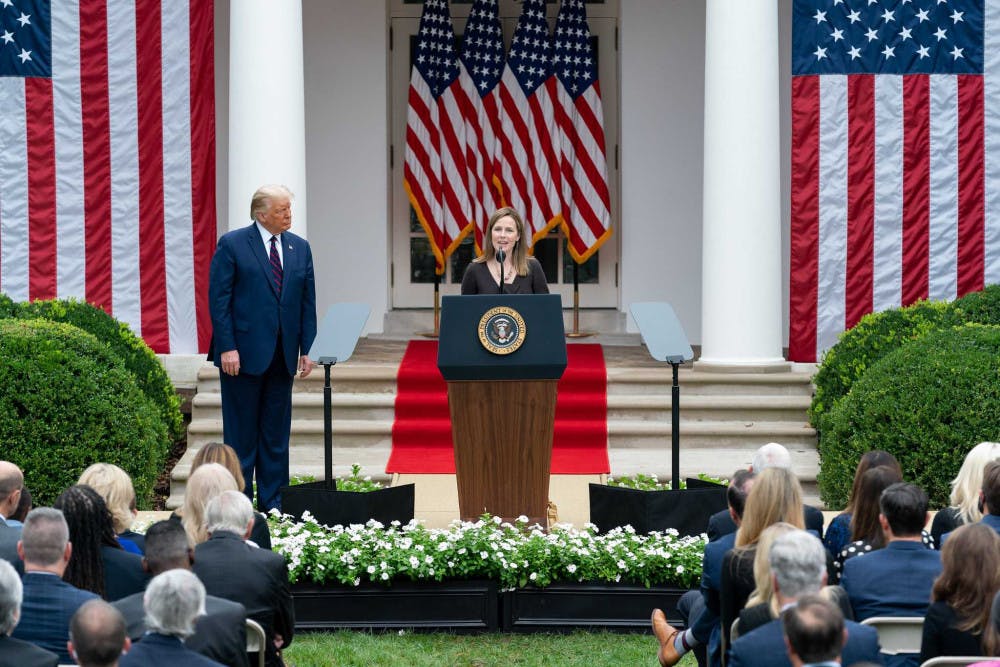Before her confirmation to the U.S. Court of Appeals for the 7th Circuit, Amy Coney Barrett worked as a professor at her alma mater, the University of Notre Dame School of Law, where she began teaching in 2002.
Since her appointment to the court in October of 2017, she has been on double duty as a professor and a federal judge.
Recently officially nominated by President Donald Trump, she will be filling the seat vacated by the late Justice Ruth Bader Ginsburg if confirmed.
But who is she, exactly?
Coney Barrett was born on January 28, 1972 in New Orleans, La. After graduating from St. Mary’s Dominican High School in 1990, she went on to attend Rhodes College, where she graduated magna cum laude with a degree in English literature in 1994. Coney then proceeded to study law at the University of Notre Dame School of Law, where she graduated first in her class in 1997. Coney Barrett also met her husband, Jesse Barrett, while attending the University of Notre Dame. In 1999, the two married, and she officially began going by Coney Barrett.
After obtaining her law degree, Coney Barrett officially began her career in the legal field working as a law clerk for Judge Laurence Silberman of the U.S. Court of Appeals for the D.C. Circuit between 1997 and 1998, and then for Justice Antonin Scalia between 1998 and 1999.
Coney Barrett moved on to work for Baker Botts, a Houston, Texas based law firm after her time working for Scalia. While employed by the firm, Coney Barrett worked on the controversial Bush v. Gore election case on behalf of George W. Bush’s team. She stayed with Baker Botts until 2002, when she began teaching at the University of Notre Dame School of Law.
During those fifteen years, alongside being a professor, Coney Barrett started a family and devoted time to her Catholic faith. She has seven children, two of which are adopted, and one of which has Down syndrome. Coney Barrett is also a member of the “tightly knit, interdenominational, charismatic lay-Christian parachurch community People of Praise.”
While at Notre Dame, Coney Barrett taught federal courts, statutory interpretation, constitutional law, and civil procedure courses, and earned the “Distinguished Professor of the Year” award three separate times.
Coney Barrett became a favorite among conservatives due to her stances on highly debated topics such as the Affordable Care Act, abortion rights and religion. She identifies herself as an originalist, meaning that she interprets the Constitution based on the literal letter of the text and the mindsets of the framers. Scalia was a famous example of an originalist. Other originalists on the current Supreme Court include Clarence Thomas and Neil Gorsuch.
In May of 2017, President Donald Trump nominated Coney Barrett to the U.S. Court of Appeals for the 7th Circuit. Four months later in September, the Senate Judiciary Committee held a hearing on her nomination.
During the hearing, democratic Senator Dianne Feinstein of California questioned Coney Barrett’s stances in a law review article on Catholic judges recusing themselves from cases involving the death penalty, worried that she would let her faith get in the way of her judicial impartiality.
Coney Barrett saw opposition of her confirmation from LGBTQ+ rights organizations, and most Democrats in the Senate, but she was ultimately confirmed to her position on the 7th Circuit by a Senate vote of 55-43 on Oct. 31, 2017.
President Trump has reportedly had Coney Barrett on his short list of potential Supreme Court nominees since 2017, and even considered her to replace Justice Anthony Kennedy after he retired. However, with Brett Kavanaugh replacing Kennedy instead, Coney Barrett became the number one contender if another seat were to open.
Now that Ginsburg’s seat is open, Coney Barrett has officially been nominated to the Supreme Court. Republicans have pushed to get her confirmed and on the bench as soon as possible. Democrats are opposing this action, pointing toward the Republicans’ own tactics of refusing to consider Merrick Garland in 2016, due to it being an election year.
Photo courtesy: Official White House Photo by Andrea Hanks












